Laparoscopic Essure tubal reversal: How we do it
With the impending withdrawal of Essure from the US market, ob/gyns should know how to remove the device. The authors describe the traditional technique and their new approach.

For over a decade, transcervical sterilization revolutionized gynecology by offering an office-based procedure for sterilization under local anesthesia. Essure® was the most successful hysteroscopic sterilization device on the market, approved for almost 16 years in the United States and with an estimated 750,000 devices sold worldwide.1 While Essure proved to be very effective in preventing pregnancy, recent years have seen a dramatic rise in the number of adverse events (AEs) associated with it reported to the US Food and Drug Administration (FDA).2 Several countries have withdrawn the product from the market and Bayer AG recently announced it will discontinue sales in the United States by the end of 2018.3
A growing number of women are now seeking surgical removal of Essure due to suspected AEs such as pelvic pain, heavy bleeding, allergic reaction, and a multitude of other symptoms that may be related to the device.4,5 Essure removal is typically performed laparoscopically by removing both fallopian tubes as well as the interstitial portion of the microinsert. Many women also choose to undergo a cornual wedge resection or hysterectomy to ensure that the device and any fragments are completely excised.

Essure regret
Less commonly discussed is the issue of sterilization regret, a condition that affects up to 20% of sterilized women and likely some women with Essure.6 Traditionally, Essure sterilization is considered irreversible due to extensive scarring along a large portion of the fallopian tube. Most patients desiring pregnancy after Essure are advised to undergo in vitro fertilization (IVF), a readily-available alternative that has shown some success with Essure in situ.7,8 But what about women who desire removal of the device and restoration of fertility? For them, a procedure that removes the device and offers even a small chance of spontaneous pregnancy might be worthwhile.
Tubouterine anastomosis
Essure reversal is uniquely challenging. The device’s polyethylene terephthalate fibers induce permanent fibrosis along almost half of the fallopian tube, including the interstitial segment. This leaves only a short segment of the distal fallopian tube available for direct attachment to the uterus. This type of procedure is termed a tubouterine anastomosis; a technique that dates back to the late 19th century (Figure 1).
Tubouterine anastomosis was first described for treating women with proximal tubal occlusion unrelated to sterilization.9 Proximal tubal occlusion can be caused by conditions such as chronic salpingitis, salpingitis isthmica nodosa, cornual fibroids, adhesive disease, and endometritis.10 Long before IVF, tubal cannulation and tubouterine anastomosis were attempted to restore tubal patency in women with proximal tubal occlusion. Tubouterine anastomosis was classically an open procedure in which fundal hysterotomy or cornual wedge resection was performed for excision of the affected fallopian tube and reimplantation of the distal fallopian tube to the uterine cornua. Conception rates following the procedure were variable, ranging from 14% to 42% in the literature.11-14
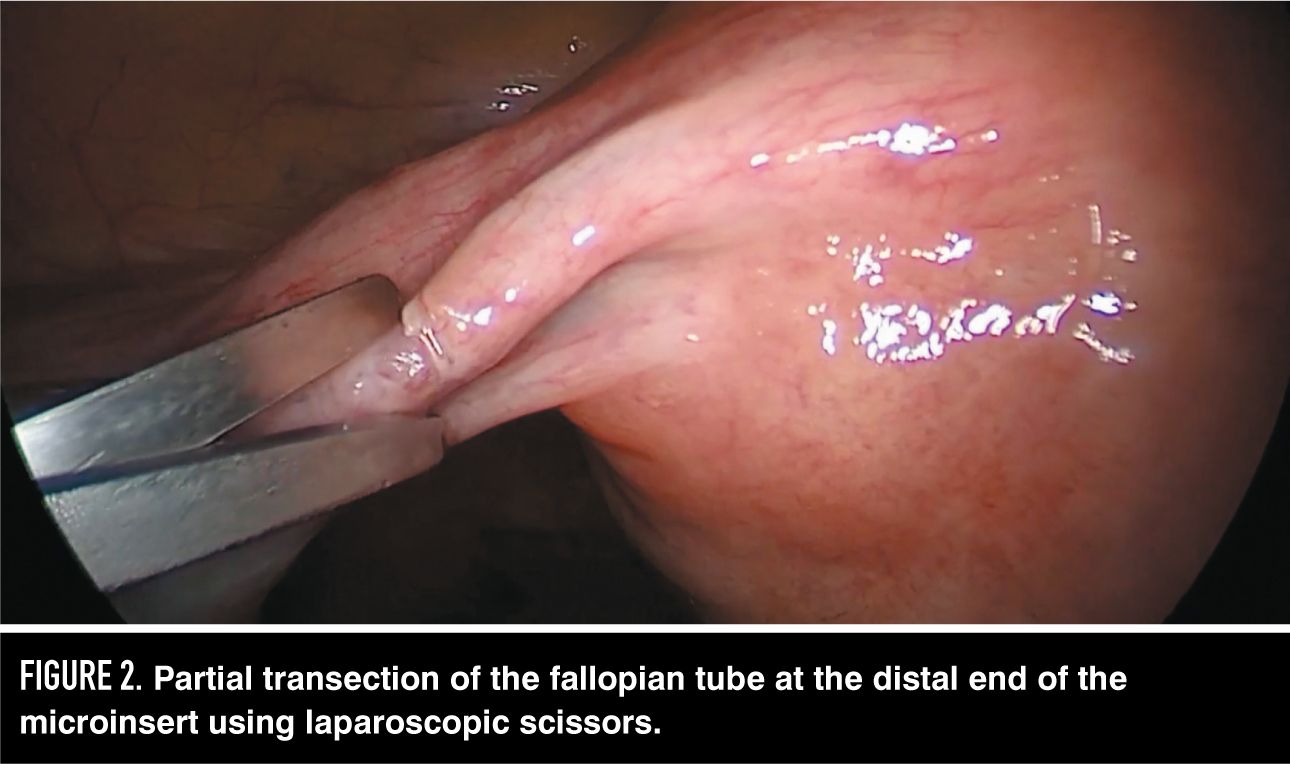
Essure reversal
Montieth et al. are the only authors to publish their experience using tubouterine anastomosis to reverse Essure sterilization. Their technique uses a 5-to 10-cm laparotomy and transfundal posterior uterine incision or cornual wedge resection to reimplant the distal fallopian tubes into the uterine cornua. In a published series of 70 cases, the 12-month post-procedural conception rate was 36%.15 A more up-to-date analysis on their website reports a 38% pregnancy rate for 282 procedures performed over 9 years.16 Also reported is a 5% ectopic rate and 4% uterine rupture rate.
A new technique
We have tested a new method for Essure reversal using a laparoscopic approach that does not require a large abdominal or uterine incision. With this method, laparoscopy and hysteroscopy are performed simultaneously to remove the device and reimplant the distal fallopian tube into a new site on the uterine fundus. We present a description and video of our technique as well as our experience with three cases.
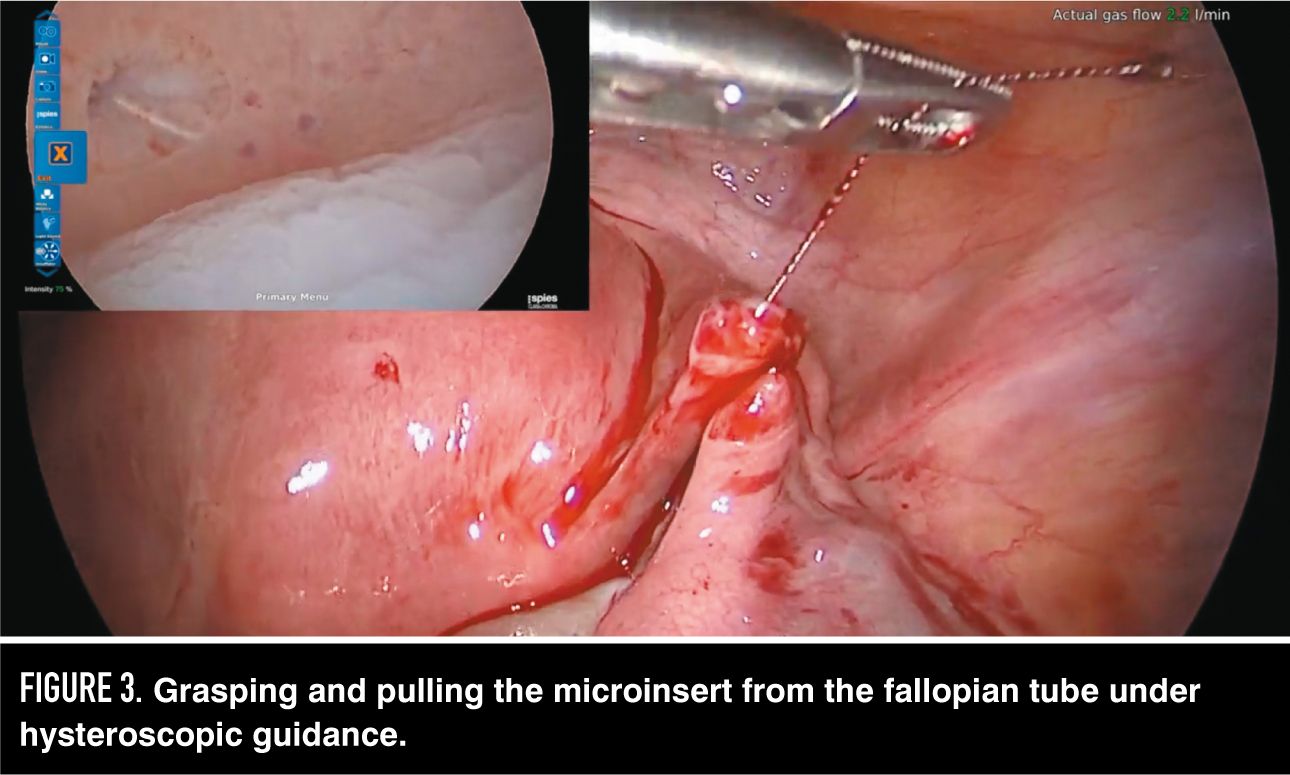
Removing the microinserts
The microinserts are identified and laparoscopic scissors are used to partially transect the fallopian tube at the distal end of the device (Figure 2). Electrosurgery is avoided to preserve as much healthy fallopian tube as possible. Once the distal end of the Essure device emerges, it is grasped laparoscopically and pulled out of the fallopian tube (Figure 3). The device uncoils and elongates as it is removed and can easily fracture. Pulling the device parallel to the tube and intermittently regrasping it near its exit from the tube can help avoid device fragmentation.
Hysteroscopic guidance
Simultaneous hysteroscopic guidance is used to ensure that the intracavitary portion of the microinsert is completely removed. We have found that a fractured device may appear to be completely removed laparoscopically, when in fact, a small portion of the proximal microinsert remains visible hysteroscopically.

Stenting the fallopian tube
Once both Essure microinserts are removed, semi-rigid stents are inserted into the tubal ostia through the operative channel of a 5-mm hysteroscope (Figure 4). Despite insertion of the stents into the tubal ostia, the stents do not emerge from the proximal fallopian tube because of the fibrosis caused by Essure. In our experience, the device instead perforates the uterine fundus slightly posterior and medial to the tubouterine junction. Once the stent emerges, it is cannulated into the distal fallopian tube segment laparoscopically.
Tubouterine anastomosis
The distal fallopian tube is brought to the uterus along the stent and the anastomosis performed. Interrupted stitches are placed circumferentially around the new tubouterine junction with knots tied intracorporeally (Figure 5). Stitches are placed until the fallopian tube is well-approximated to the uterus and the stent is no longer visible. The process is repeated on the other side and the stents are removed. At the end of the procedure, chromopertubation is used to assess tubal patency (Figure 6).
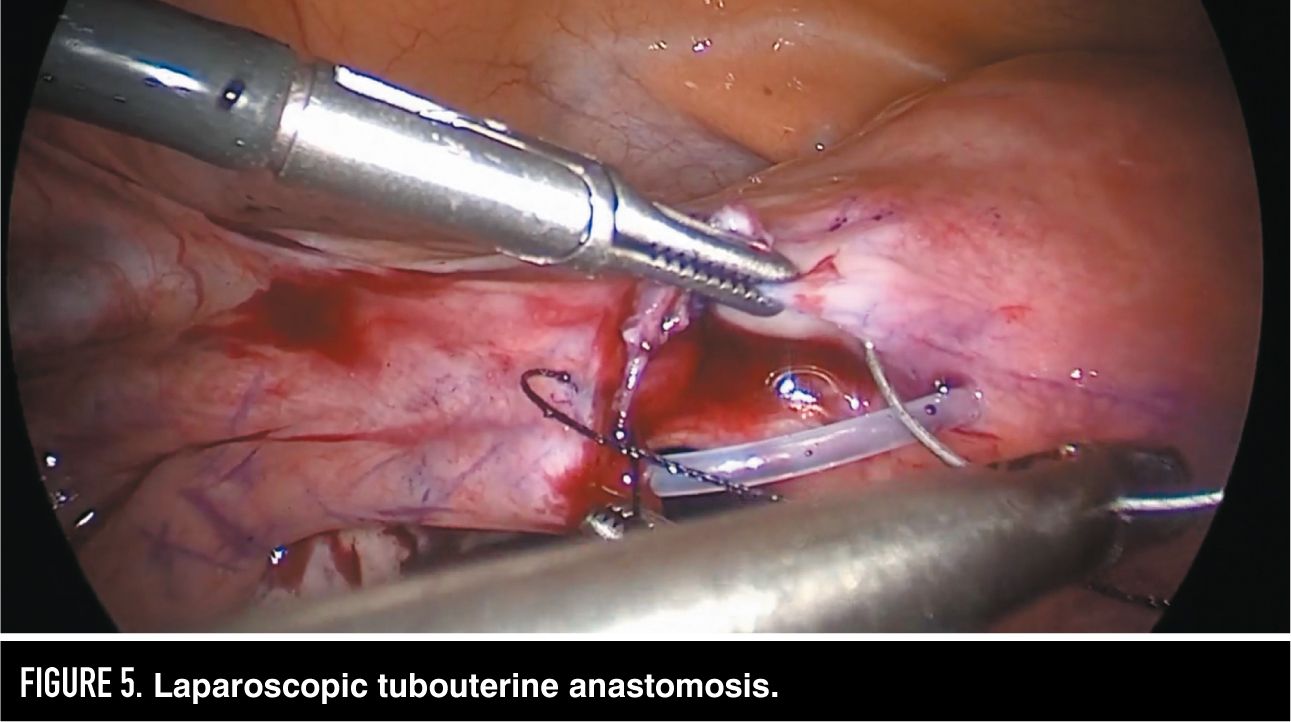
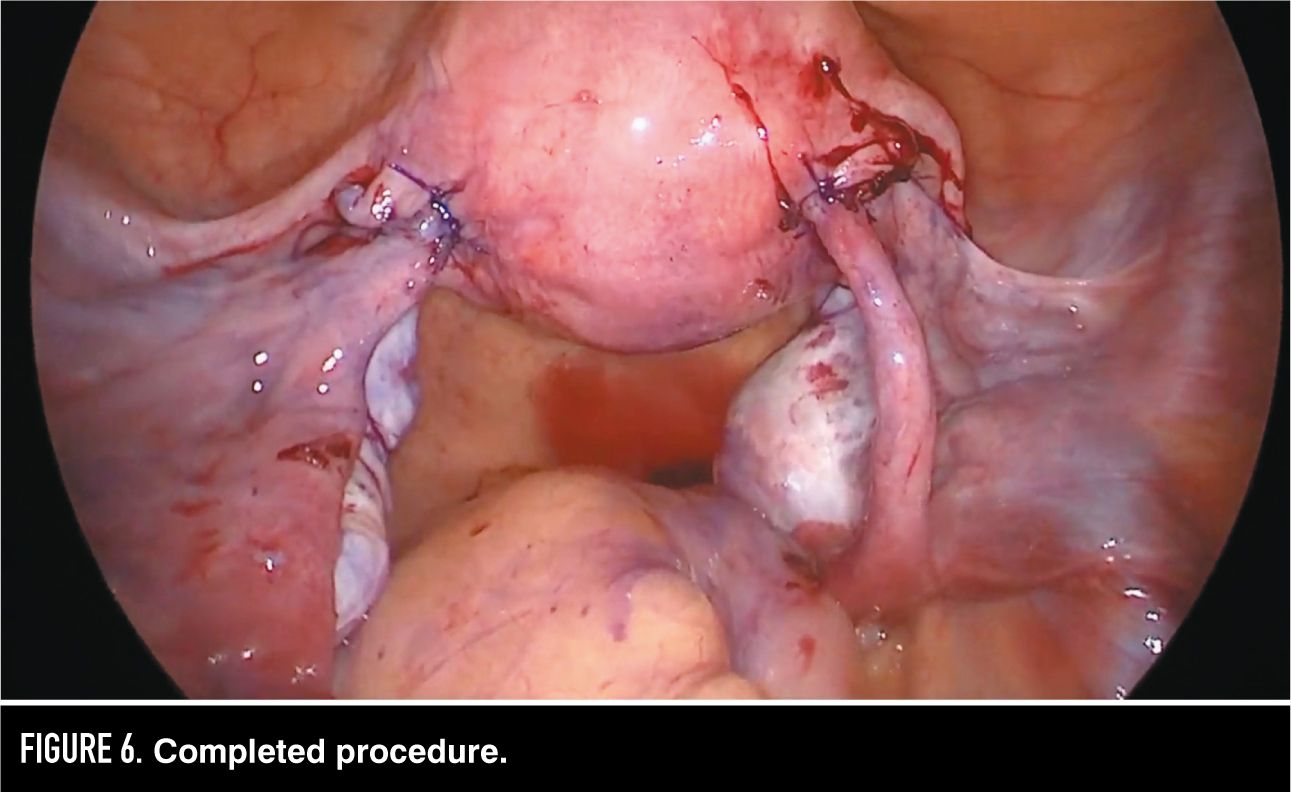
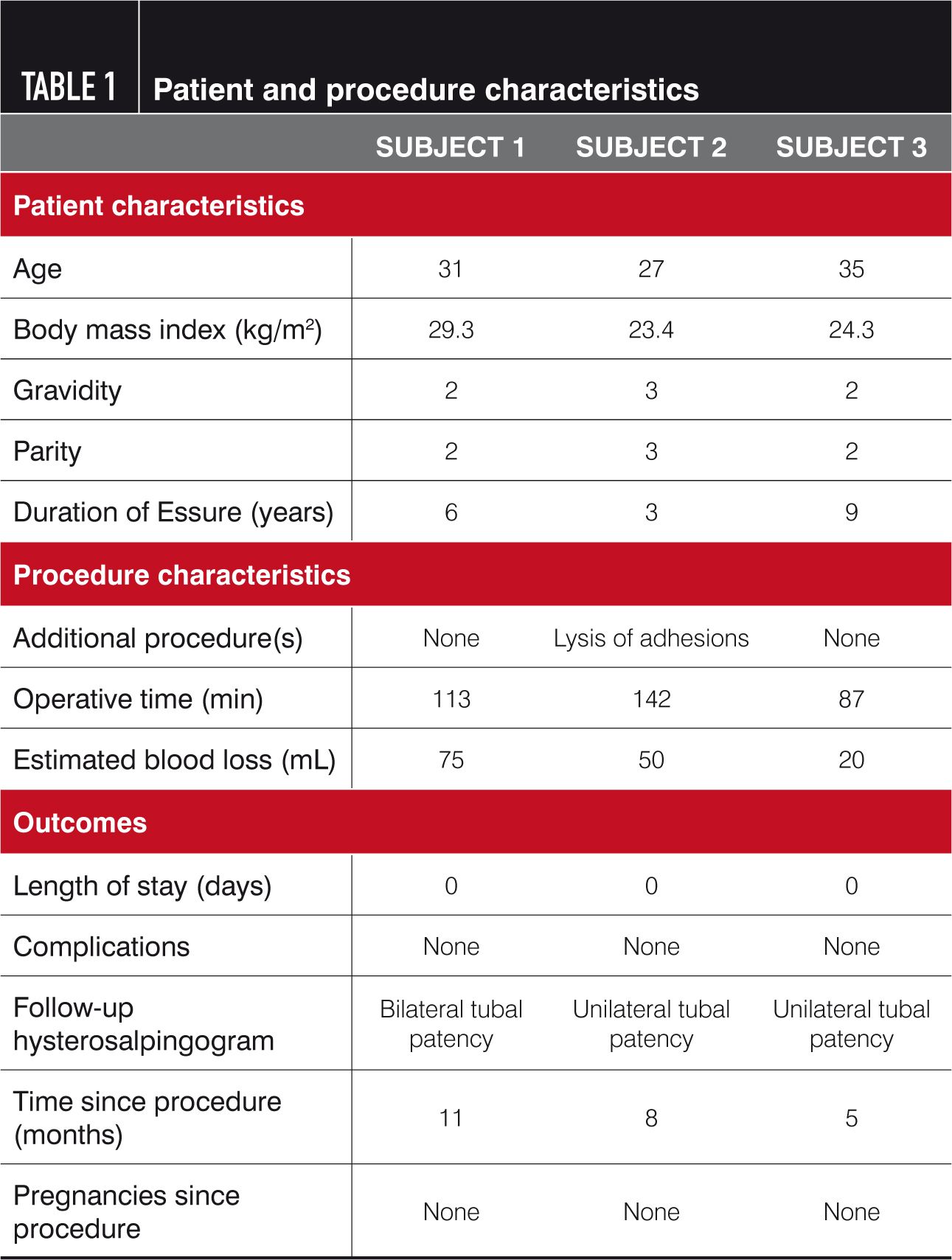
Experience with three cases
Three laparoscopic Essure reversal procedures were performed at Brigham and Women’s Hospital between 2017 and 2018 using this technique (Table 1). All three patients were in their 20s when they underwent Essure sterilization and later regretted the procedure. All were experiencing side effects of the Essure device and had a history of spontaneous pregnancies prior to sterilization. The three women were 27 to 35 years of age at the time of Essure reversal.
Operative time ranged from 87 to 142 minutes and estimated blood loss was minimal at 20 to 75 mL. All procedures were uncomplicated and patients were discharged home on the same day as surgery. A follow-up hysterosalpingogram was done 1 to 3 months following the procedure and showed bilateral patency in one case and unilateral patency in the other two cases. While restoration of tubal patency is promising, no pregnancies have occurred over a follow-up period of 5 to 11 months. If the patients are able to conceive, risk of uterine rupture may be reduced by avoiding a hysterotomy or cornual wedge resection.
What about IVF?
IVF is still a good option for most women who desire pregnancy after Essure, especially if the device is not causing symptoms. Literature on IVF for Essure regret is limited to a report of two cases, both of which resulted in a live birth.9 Several small studies have also evaluated intentional placement of Essure prior to IVF for infertile women with hydrosalpinx.8 In this setting, the microinserts occlude the proximal fallopian tube and prevent hydrosalpingeal fluid from spilling into the uterine cavity. A systematic review of Essure and IVF for infertile women with hydrosalpinx reported a 29% ongoing pregnancy and live birth rate.7 Presumably, IVF success rates for Essure regret are greater than those in women with underlying infertility.
When weighing the risks and benefits of IVF compared to Essure reversal, it is worth considering what we know about IVF and tubal reanastomosis after tubal ligation. As with any fertility procedure, tubal reanastomosis after tubal ligation is more likely to benefit younger women.17A retrospective study by Boechxstaens et al. found that cumulative delivery rates were significantly greater after tubal reanastomosis compared to IVF in women younger than age 37 (72% vs. 52% over 72 months).18 A decision analysis by Messinger et al found that tubal reanastomosis was more cost-effective for women younger than age 41, whereas IVF was more cost-effective for women aged 41 and older.19 Essure reversal is also assumed to be less advantageous for older women.
Important considerations
Essure reversal with tubouterine anastomosis is technically and functionally a different procedure from tubal reversal with end-to-end anastomosis of the fallopian tube. The greater extent of tubal damage following Essure sterilization is very likely to result in lower success rates than other tubal reversal procedures. While laparoscopic Essure reversal can restore tubal patency, it is currently unknown if it can result in a normal pregnancy. Nevertheless, the opportunity to remove a device associated with symptoms may prompt younger women with Essure regret to attempt reversal despite presumably low success rates.
Disclosures:
The authors report no potential conflicts of interest with regard to this article.
References:
- Bayer. Essure permanent birth control. http://www.essure.com/what-is-essure. Accessed August 15, 2018.
- Walter JR, Ghobadi CW, Hayman E, Xu S. Hysteroscopic Sterilization With Essure: Summary of the U.S. Food and Drug Administration Actions and Policy Implications for Postmarketing Surveillance. Obstet Gynecol. 2017;129(1):10-19.
- Mohan N. Bayer to stop selling Essure in the U.S. Wall Street Journal. July 20th, 2018.
- Kamencic H, Thiel L, Karreman E, Thiel J. Does Essure cause significant de novo pain? a retrospective review of indications for second surgeries after Essure placement. J Minim Invasive Gynecol. 2016;23(7):1158-1162.
- Clark NV, Rademaker D, Mushinski AA, Ajao MO, Cohen SL, Einarsson JI. Essure removal for the treatment of device-attributed symptoms: an expanded case series and follow-up survey. J Minim Invasive Gynecol. 2017;24(6):971-976.
- Hillis SD, Marchbanks PA, Tylor LR, Peterson HB. Poststerilization regret: findings from the United States Collaborative Review of Sterilization. Obstet Gynecol. 1999;93(6):889-895.
- Arora P, Arora RS, Cahill D. Essure® for management of hydrosalpinx prior to in vitro fertilization-a systematic review and pooled analysis. BJOG. 2014;121:527–536.
- Kerin JF, Cattanach S. Successful pregnancy outcome with the use of the in vitro fertilization after Essure hysteroscopic sterilization. Fertil Steril. 2007;87:1212.e1-4.
- Reis E. Plastic operation on the fallopian tubes. Am J Surg Gynecol. 1899;11:180.
- De Silva PM, Chu JJ, Gallos ID, Vidyasagar AT, Robinson L, Coomarasamy A. Fallopian tube catheterization in the treatment of proximal tubal occlusion: a systematic review and meta-analysis. Hum Reprod. 2017;32(4):836-852.
- Turck RC. Hysterosalpingostomy. NY Med J. 1909;89:1193-1196.
- Williams GF. Tubo-uterine implantation with special reference to reversal of sterilization. Lancet. 1969;1(7599):825-827.
- Green-Armytage VG. Tubo-uterine implantation. J Obstet Gynaecol Br Emp. 1957;64:47.
- Diamond E. A comparison of gross and microsurgical techniques for repair of cornual occlusion in infertility: a retrospective study, 1968–1978. Fertil Steril. 1979;32:370-376.
- Montieth CW, Berger GS, Zerden ML. pregnancy success after hysteroscopic sterilization reversal. Obstet Gynecol. 2014;124(6):1183-1189.
- Tubal Reversal A Personal Choice. https://www.tubal-reversal.net/. Accessed August 15, 2018.
- Trussel J, Guilbert E, Hedley A. Sterilization failure, sterilization reversal, and pregnancy after sterilization reversal in Quebec. Obstet Gynecol. 2003;101(4):677.
- Boeckxstaens A, Devroey P, Collins J, Tournaye H. Getting pregnant after tubal sterilization: surgical reversal or IVF? Hum Reprod. 2007;22(10):2660.
- Messinger LB, Alford CE, Csokmay JM, Henne MB, Mumford SL, Segars JH, Armstrong AY. Cost and efficacy comparison of in vitro fertilization and tubal anastomosis for women after tubal ligation. Fertil Steril. 2015;104(10):32-38.
Recap on reproductive rights with David Hackney, MD, MS
December 20th 2022In this episode of Pap Talk, we spoke with David Hackney, MD, MS, maternal-fetal medicine physician at Case Western Reserve University and chair of ACOG's Ohio chapter for a full recap of where restrictions on reproductive rights have been and where they're going.
Listen
In this episode of Pap Talk, Gloria Bachmann, MD, MSc, breaks down what it means to be a health care provider for incarcerated individuals, and explores the specific challenges women and their providers face during and after incarceration. Joined by sexual health expert Michael Krychman, MD, Bachmann also discusses trauma-informed care and how providers can get informed.
Listen
